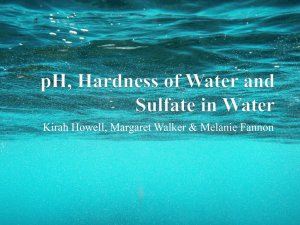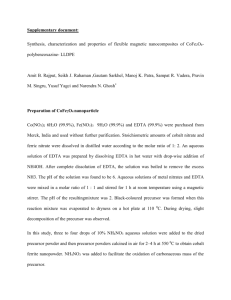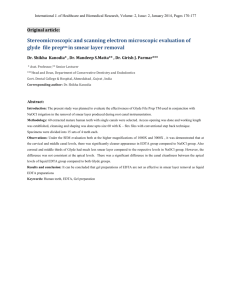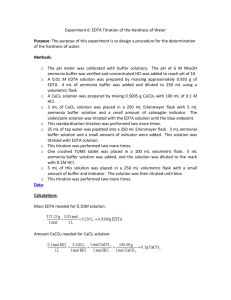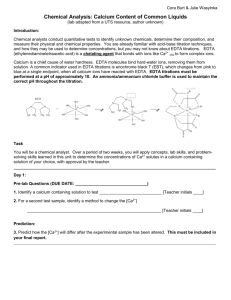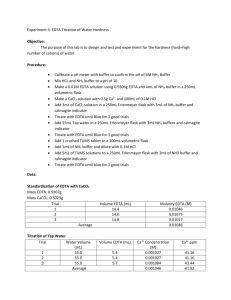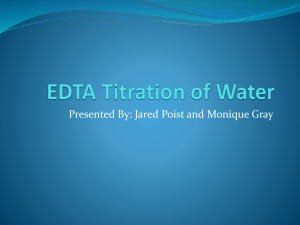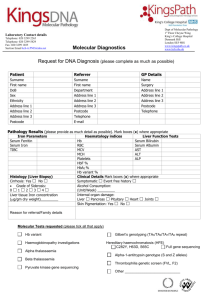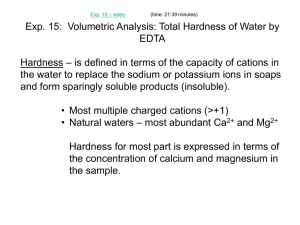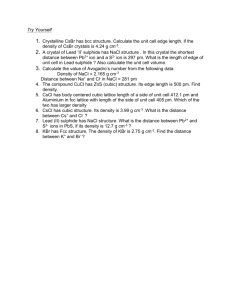Real World Experiment
advertisement
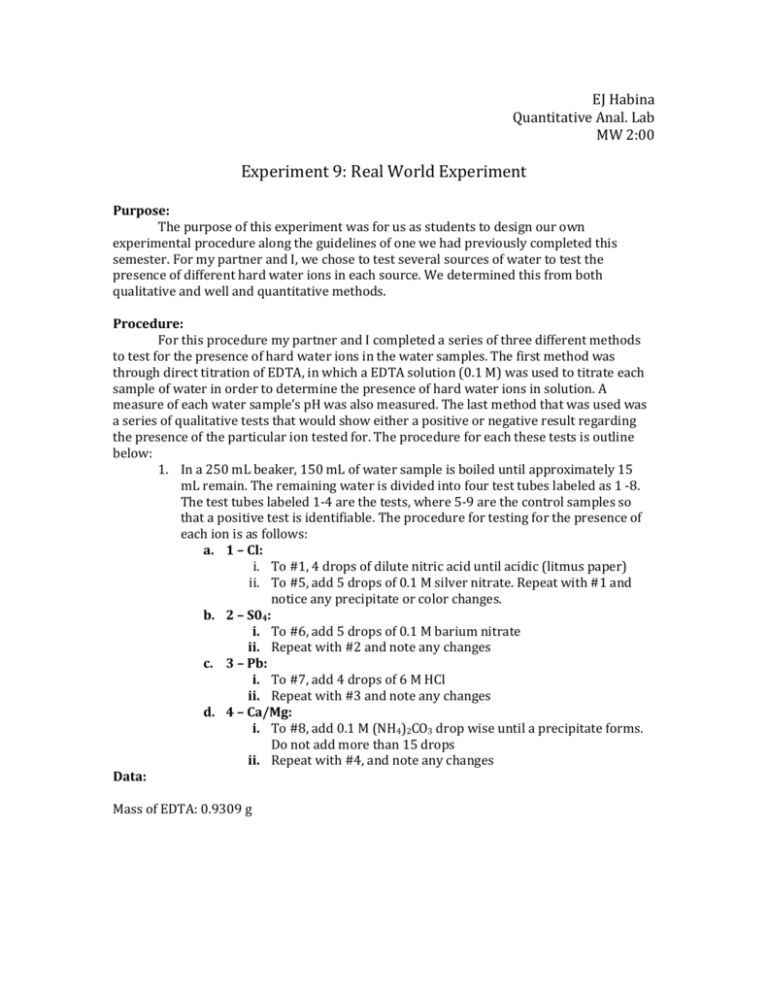
EJ Habina Quantitative Anal. Lab MW 2:00 Experiment 9: Real World Experiment Purpose: The purpose of this experiment was for us as students to design our own experimental procedure along the guidelines of one we had previously completed this semester. For my partner and I, we chose to test several sources of water to test the presence of different hard water ions in each source. We determined this from both qualitative and well and quantitative methods. Procedure: For this procedure my partner and I completed a series of three different methods to test for the presence of hard water ions in the water samples. The first method was through direct titration of EDTA, in which a EDTA solution (0.1 M) was used to titrate each sample of water in order to determine the presence of hard water ions in solution. A measure of each water sample’s pH was also measured. The last method that was used was a series of qualitative tests that would show either a positive or negative result regarding the presence of the particular ion tested for. The procedure for each these tests is outline below: 1. In a 250 mL beaker, 150 mL of water sample is boiled until approximately 15 mL remain. The remaining water is divided into four test tubes labeled as 1 -8. The test tubes labeled 1-4 are the tests, where 5-9 are the control samples so that a positive test is identifiable. The procedure for testing for the presence of each ion is as follows: a. 1 – Cl: i. To #1, 4 drops of dilute nitric acid until acidic (litmus paper) ii. To #5, add 5 drops of 0.1 M silver nitrate. Repeat with #1 and notice any precipitate or color changes. b. 2 – S04: i. To #6, add 5 drops of 0.1 M barium nitrate ii. Repeat with #2 and note any changes c. 3 – Pb: i. To #7, add 4 drops of 6 M HCl ii. Repeat with #3 and note any changes d. 4 – Ca/Mg: i. To #8, add 0.1 M (NH4)2CO3 drop wise until a precipitate forms. Do not add more than 15 drops ii. Repeat with #4, and note any changes Data: Mass of EDTA: 0.9309 g EDTA Titration of Water Samples: Dr. Peterman's Well Water: Trial 1 Trial 2 mL EDTA 6.1 6.1 Trial 3 6.1 Average 6.1 Moles of EDTA 0.000181 [Ca] gr/gal 0.424 Off Campus Water: Trial 1 mL EDTA 4.5 Trial 2 4.4 Trial 3 4.2 Average 4.37 Moles of EDTA 0.00033 [Ca] gr/gal 0.773 Trial 1 8.2 Trial 2 8.3 Trial 3 8.3 Average 8.27 Moles of EDTA 0.000174 [Ca] gr/gal 0.408 On Campus Water: Trial 1 mL EDTA 4.6 Trial 2 4.6 Trial 3 4.4 Average 4.53 Moles of EDTA 0.000243 [Ca] gr/gal 0.569 Creek Water: mL EDTA Dissolved Hard Water Ion Tests: Positive Test Results: Sulfate Test Lead Test Chloride Test The solution turns an extremely opague, cloudy white and a precipitate forms settling on bottom of test tube. Calcium/Magnesium Test The solution turns an Small, bright white opaque white color with powder-like precipitate visible precipate forms and settles of the particles suspended in bottom of the test tube; the solution. "snow-like". Not a significant change in color, but faint white swirls appear as drops are added. Grain-like precipitate slowly forms on bottom of test tube. Dr. Peterman's Well Water: Chloride Result + Sulfate + Lead - Ca/Mg + Off Campus Water: Chloride Result + Sulfate + Lead - Ca/Mg + Creek Water: Chloride + Sulfate + Lead - Ca/Mg + On Campus Water: Chloride Result + Sulfate + Lead - Ca/Mg + Result pH Test: pH Test Sample pH Dr. Peterman's Well Water 7.7 Off Campus Water 8.02 Creek Water 8.03 On Campus Water 7.77 Calculations: Concentration of EDTA: 𝑚𝑎𝑠𝑠 𝐸𝐷𝑇𝐴 (𝑔) × Ex: (0.9309 𝑔 𝐸𝐷𝑇𝐴) × 1 𝑚𝑜𝑙 𝐸𝐷𝑇𝐴 = 𝑀 𝐸𝐷𝑇𝐴 374.24 𝑔 1 𝑚𝑜𝑙 𝐸𝐷𝑇𝐴 1 × = 0.0399𝑀 𝐸𝐷𝑇𝐴 374.24 𝑔 0.250 𝐿 Moles of EDTA Used: 𝑀 𝐸𝐷𝑇𝐴 × 𝑣𝑜𝑙𝑢𝑚𝑒 𝑜𝑓 𝐸𝐷𝑇𝐴 𝑢𝑠𝑒𝑑 (𝐿) = 𝑚𝑜𝑙𝑒𝑠 𝑜𝑓 𝐸𝐷𝑇𝐴 𝑢𝑠𝑒𝑑 Ex: 0.0399 𝑀 𝐸𝐷𝑇𝐴 × 0.00453 𝐿 𝐸𝐷𝑇𝐴 = 1.81 × 10−4 𝑚𝑜𝑙𝑒𝑠 𝑜𝑓 𝐸𝐷𝑇𝐴 𝑢𝑠𝑒𝑑 Moles of Hard Water Ions: 𝑚𝑜𝑙𝑒𝑠 𝑜𝑓 𝐸𝐷𝑇𝐴 𝑢𝑠𝑒𝑑 = 𝑚𝑜𝑙𝑒𝑠 𝐻𝑎𝑟𝑑 𝑊𝑎𝑡𝑒𝑟 𝑖𝑜𝑛𝑠 = 𝐶𝑎+2 𝑖𝑜𝑛𝑠 Ex: 1.81 × 10−4 𝑚𝑜𝑙𝑒𝑠 𝑜𝑓 𝐸𝐷𝑇𝐴 𝑢𝑠𝑒𝑑 = 1.81 × 10−4 𝑚𝑜𝑙𝑒𝑠 𝐻𝑎𝑟𝑑 𝑊𝑎𝑡𝑒𝑟 𝑖𝑜𝑛𝑠 = 1.81 × 10−4 𝐶𝑎+2 𝑖𝑜𝑛𝑠 Concentration of Hard Water Ions: 𝑚𝑜𝑙𝑒𝑠 𝐻𝑎𝑟𝑑 𝑤𝑎𝑡𝑒𝑟 𝑖𝑜𝑛𝑠 = 𝑚𝑜𝑙𝑒𝑠 𝐶𝑎+2 × 𝐶𝑎+2 𝑝𝑝𝑚 × 40.078 𝑔 𝑔𝑟𝑎𝑚𝑠 𝐶𝑎+2 𝑖𝑜𝑛𝑠 1000 𝑚𝑔 = × = 𝑝𝑝𝑚 1 𝑚𝑜𝑙 𝐿 1 𝑔𝑟𝑎𝑚 1 𝑔𝑟𝑎𝑖𝑛𝑠 = 𝐶𝑎+2 𝑖𝑛 17.1 𝑔𝑎𝑙 Ex: 1.81 × 10−4 𝑚𝑜𝑙𝑒𝑠 𝐶𝑎+2 × 40.078 𝑔 0.00725 𝑔 𝐶𝑎+2 𝑖𝑜𝑛𝑠 1000 𝑚𝑔 = × = 7.25 𝑝𝑝𝑚 1 𝑚𝑜𝑙 𝐿 1 𝑔𝑟𝑎𝑚 𝐶𝑎+2 𝑝𝑝𝑚 × 1 𝑔𝑟𝑎𝑖𝑛𝑠 +2 = 0.423 𝐶𝑎 17.1 𝑔𝑎𝑙
